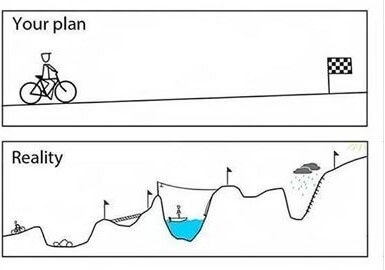Persistence is the third part of the creative process (THP, ALA, Persist). THP is your plan; ALA is your execution of the plan. Now, you need persistence to help you reach THERE.
It takes more focus and energy to persist in challenging times because it is so easy to give up.
You need persistence to...
Persistence also produces momentum and encourages you to go beyond understanding the need to change to MAKING THE CHANGE.

Persistence
You start by identifying a clear THERE, something you want, a desired end result. You commit to it and then determine where you are (HERE) in relationship to that want. Then, you create actions (PATH) and act, learn, and adjust (ALA) to help you get closer to THERE.
As you travel the PATH, you find that you need persistence, and you need it often. And, the closer you get to THERE, the more persistence you need. At some point along the PATH, as you get closer to THERE, you change from "traveling" to "arriving." When you are still in the "traveling" mindset, you need persistence to keep pressing forward to reach the destination. But, in the "arriving" mindset, you need persistence to finish strong instead of stopping or starting work on another THERE.
Persistence is a close cousin to commitment, which you start with when you choose THERE. The synonyms of "tenacity, dogged determination" provide an excellent picture of what you need as you are on the PATH, especially as you get closer to THERE.
Additionally, the more obstacles you face, the more complex the situation requires even more persistence.
Try This Exercise
When working on any project, especially difficult ones, it helps to understand how most projects change over time. There is often a big difference between expectations and reality.
Try this exercise with your project group or team. They only need a blank sheet of paper and a pencil or pen. Ask them to write START on the left side of the page and FINISH on the right. Then, ask them to draw a line from START to FINISH on how they think the project will go.

You will see lines that go straight across, down then up, up then down, and various other options. After you discuss their explanations and reasons for the shape of their lines, tell them that the basic shape almost always resembles a "U".
Project MOOD Curve
The MOOD Curve helps you and others persist. It is a simple tool that people easily understand because they have experienced it.
When you start a project, you may have early success, but then you see obstacles that were not anticipated. That's when you feel like a failure and think you are in the “Valley of Despair.” If you aren’t self-governing and willing to overcome obstacles, there will be finger-pointing and blaming.
But, the reality is, those times are not the "Valley of Despair"; they are the "Valley of Insight."
Whenever things go poorly, because it will happen, help people learn to ask, "What are we learning?" That helps them keep moving forward, even though it feels like failure. As the leader, these are the times you help people grow.
People do not like to be associated with failure because they have an improper view of it. Failure is just another part of success, and the MOOD Curve helps your group get through those times quickly.
Teach your mouth to stop blaming and complaining when things aren’t going well. Instead, look for ways to help others and be a part of the solution.
The MOOD Curve is a simple tool that explains a lot. Make sure that people know about it at the start of a project. Reinforce learning and reduce blaming with the great question, “What are we learning?”
Persistence Takes Time
Finally, the Creative Process is like exercise – the benefits accrue over time. Exercising, not watching exercise videos, creates the benefits for you. And, with the Creative Process, making a clear THERE, a clear HERE, taking actions, and reaching THERE will most often take a lot of time and persistence.
You will become more adept with the Creative Process by using it and persisting with it.
How's your persistence? Are you PERSISTING to get to the finish and help others finish?
GR8 Leaders persist!
